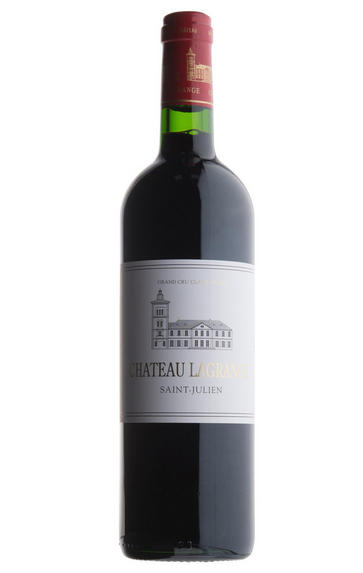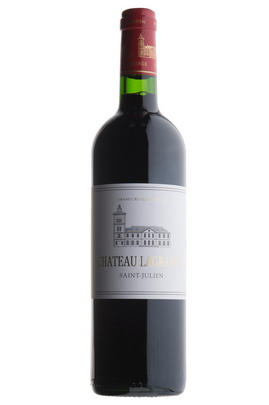
2022 Château Lagrange, St Julien, Bordeaux

Critics reviews
The 2022 Lagrange was picked between 8 and 30 September, it ages in 60% new oak for a planned 21 months. It has an almost clinical bouquet, with very well-defined blackberry and blueberry fruit, graphite and crushed stone. Quite a gap in quality between this and the Fiefs de Lagrange this year.
The palate is extremely pure with cashmere tannins, black cherry fruit infused by blood orange, lightly spiced, and hints of white pepper toward a very concentrated, fine-boned finish. This will require several years in bottle, but it will be worth waiting for. A serious and very able Lagrange that should not be underestimated.
Drink 2029 – 2055
Neal Martin, Vinous.com (April 2023)
A Lagrange with real depth and restaint, feels so pefectly Left Bank, really impresive, a wine that shows the true possibilities of the vintage. There is a build up of tannins through the palate, but also a juiciness and a gorgeous cassis, bilberry and fresh cherry pit seduction, with huge confidence and clear ageing potential.
Drink 2030 - 2046
Jane Anson, JaneAnson.com (May 2023)
The 2022 Lagrange is brilliant, ranking alongside the 2020, 2019 and 2016 as one of this over-performing estate's finest recent vintages. Revealing aromas of dark cherries, cassis, violets and pencil shavings, it's medium to full-bodied, velvety and layered, with a deep core of fruit, beautifully refined but youthfully assertive tannins and a long, mouthwatering finish. It's a blend of 86% Cabernet Sauvignon, 12% Merlot and 2% Petit Verdot with a very healthy pH of 3.63.
William Kelley, Wine Advocate (April 2023)
Dark fruit with a strong Cabernet-cassis profile. Layered and firm on the palate but fresh and digeste as well. Builds to a long, persistent finish. Linear and direct. Ageing potential.
Drink 2030 - 2045
James Lawther MW, JancisRobinson.com (April 2023)
Solid Lagrange with blueberry and blackberry character. Medium body and a tannin structure that unfolds at the finish. Very well done.
James Suckling, JamesSuckling.com (April 2023)
The 2022 Château Lagrange is more mid-weight than I expected, yet it's nicely balanced and certainly elegant. Based on 86% Cabernet Sauvignon, 12% Merlot, and 2% Petit Verdot pulled from just 40% of the total production, it has a pretty nose of cassis and black raspberry fruits as well as some floral and spicy nuances. Its oak is nicely integrated, it's medium to full-bodied, and it has fine tannins. The barrel review will seem low if this puts on weight over the course of its élevage.
Jeb Dunnuck, JebDunnuck.com (May 2023)
About this WINE

Chateau Lagrange
Château Lagrange was for many years perceived as a tired, underperforming St Julien château that was unworthy of its 3ème Cru Classé status.
In 1983 it was purchased by the Japanese Suntory Group which set about renovating the vineyards and the winery. Lagrange rose to become a model estate and even today few Bordeaux properties can match Lagrange, with its huge barrique chais and its state of the art cuvier with its 56 temperature-controlled, stainless steel cuvées.

St Julien
St Julien is the smallest of the "Big Four" Médoc communes. Although, without any First Growths, St Julien is recognised to be the most consistent of the main communes, with several châteaux turning out impressive wines year after year.
St Julien itself is much more of a village than Pauillac and almost all of the notable properties lie to its south. Its most northerly château is Ch. Léoville Las Cases (whose vineyards actually adjoin those of Latour in Pauillac) but, further south, suitable vineyard land gives way to arable farming and livestock until the Margaux appellation is reached.
The soil is gravelly and finer than that of Pauillac, and without the iron content which gives Pauillac its stature. The homogeneous soils in the vineyards (which extend over a relatively small area of just over 700 hectares) give the commune a unified character.
The wines can be assessed as much by texture as flavour, and there is a sleek, wholesome character to the best. Elegance, harmony and perfect balance and weight, with hints of cassis and cedar, are what epitomise classic St Julien wines. At their very best they combine Margaux’s elegance and refinement with Pauillac’s power and substance.
Ch. Léoville Las Cases produces arguably the most sought-after St Julien, and in any reassessment of the 1855 Classification it would almost certainly warrant being elevated to First Growth status.
Recommended Châteaux: Ch. Léoville Las Cases, Ch.Léoville Barton, Ch Léoville Poyferré, Ch. Ducru-Beaucaillou, Ch Langoa Barton, Ch Gruaud Larose, Ch. Branaire-Ducru, Ch. Beychevelle

Cabernet Sauvignon Blend
Cabernet Sauvignon lends itself particularly well in blends with Merlot. This is actually the archetypal Bordeaux blend, though in different proportions in the sub-regions and sometimes topped up with Cabernet Franc, Malbec, and Petit Verdot.
In the Médoc and Graves the percentage of Cabernet Sauvignon in the blend can range from 95% (Mouton-Rothschild) to as low as 40%. It is particularly suited to the dry, warm, free- draining, gravel-rich soils and is responsible for the redolent cassis characteristics as well as the depth of colour, tannic structure and pronounced acidity of Médoc wines. However 100% Cabernet Sauvignon wines can be slightly hollow-tasting in the middle palate and Merlot with its generous, fleshy fruit flavours acts as a perfect foil by filling in this cavity.
In St-Emilion and Pomerol, the blends are Merlot dominated as Cabernet Sauvignon can struggle to ripen there - when it is included, it adds structure and body to the wine. Sassicaia is the most famous Bordeaux blend in Italy and has spawned many imitations, whereby the blend is now firmly established in the New World and particularly in California and Australia.


Buying options
Add to wishlist
Description
There’s a record proportion of Cabernet Sauvignon this year. Director Matthieu Bordes describes the vintage as “serene”: conditions were such that the team could choose the perfect moment to harvest. The volume of juice was disappointing, however: Matthieu expected 48hl/ha but got 34hl/ha, with a juice-to-skin ratio of 50-50 (normally about 2:1).
This wine revels in the velvety textures of the tannins in 2022. It is big, plump, alluring and impressive. The fruit is built around an array of berries: blackberry, blueberry, cranberry and bilberry. The contrast on the palate comes from heady spice notes. This is another positive and high-quality wine from this large estate.
Cabernet Sauvignon 86%; Merlot 12%; Petit Verdot 2%
Drink 2030 - 2050
Score: 17/20
Berry Bros. & Rudd (April 2023)
wine at a glance
Delivery and quality guarantee